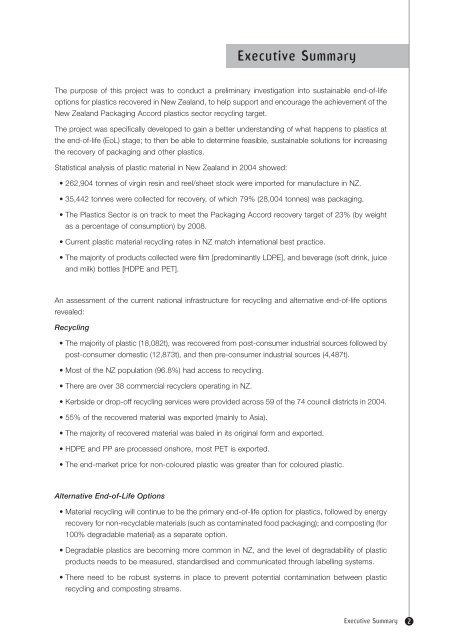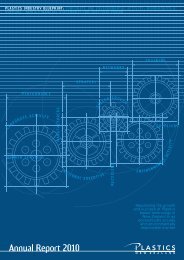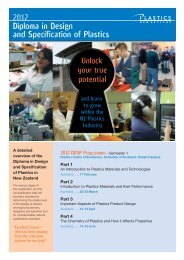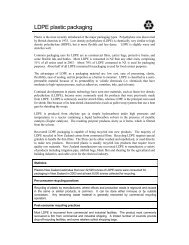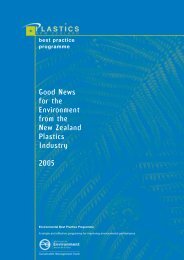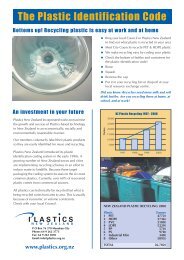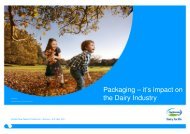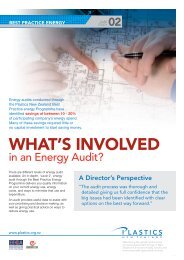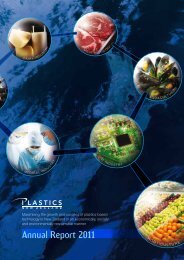Sustainable End-of-Life Options for Plastics in New Zealand
Sustainable End-of-Life Options for Plastics in New Zealand
Sustainable End-of-Life Options for Plastics in New Zealand
Create successful ePaper yourself
Turn your PDF publications into a flip-book with our unique Google optimized e-Paper software.
Executive Summary<br />
The purpose <strong>of</strong> this project was to conduct a prelim<strong>in</strong>ary <strong>in</strong>vestigation <strong>in</strong>to susta<strong>in</strong>able end-<strong>of</strong>-life<br />
options <strong>for</strong> plastics recovered <strong>in</strong> <strong>New</strong> <strong>Zealand</strong>, to help support and encourage the achievement <strong>of</strong> the<br />
<strong>New</strong> <strong>Zealand</strong> Packag<strong>in</strong>g Accord plastics sector recycl<strong>in</strong>g target.<br />
The project was specifically developed to ga<strong>in</strong> a better understand<strong>in</strong>g <strong>of</strong> what happens to plastics at<br />
the end-<strong>of</strong>-life (EoL) stage; to then be able to determ<strong>in</strong>e feasible, susta<strong>in</strong>able solutions <strong>for</strong> <strong>in</strong>creas<strong>in</strong>g<br />
the recovery <strong>of</strong> packag<strong>in</strong>g and other plastics.<br />
Statistical analysis <strong>of</strong> plastic material <strong>in</strong> <strong>New</strong> <strong>Zealand</strong> <strong>in</strong> 2004 showed:<br />
• 262,904 tonnes <strong>of</strong> virg<strong>in</strong> res<strong>in</strong> and reel/sheet stock were imported <strong>for</strong> manufacture <strong>in</strong> NZ.<br />
• 35,442 tonnes were collected <strong>for</strong> recovery, <strong>of</strong> which 79% (28,004 tonnes) was packag<strong>in</strong>g.<br />
• The <strong>Plastics</strong> Sector is on track to meet the Packag<strong>in</strong>g Accord recovery target <strong>of</strong> 23% (by weight<br />
as a percentage <strong>of</strong> consumption) by 2008.<br />
• Current plastic material recycl<strong>in</strong>g rates <strong>in</strong> NZ match <strong>in</strong>ternational best practice.<br />
• The majority <strong>of</strong> products collected were film [predom<strong>in</strong>antly LDPE], and beverage (s<strong>of</strong>t dr<strong>in</strong>k, juice<br />
and milk) bottles [HDPE and PET].<br />
An assessment <strong>of</strong> the current national <strong>in</strong>frastructure <strong>for</strong> recycl<strong>in</strong>g and alternative end-<strong>of</strong>-life options<br />
revealed:<br />
Recycl<strong>in</strong>g<br />
• The majority <strong>of</strong> plastic (18,082t), was recovered from post-consumer <strong>in</strong>dustrial sources followed by<br />
post-consumer domestic (12,873t), and then pre-consumer <strong>in</strong>dustrial sources (4,487t).<br />
• Most <strong>of</strong> the NZ population (96.8%) had access to recycl<strong>in</strong>g.<br />
• There are over 38 commercial recyclers operat<strong>in</strong>g <strong>in</strong> NZ.<br />
• Kerbside or drop-<strong>of</strong>f recycl<strong>in</strong>g services were provided across 59 <strong>of</strong> the 74 council districts <strong>in</strong> 2004.<br />
• 55% <strong>of</strong> the recovered material was exported (ma<strong>in</strong>ly to Asia).<br />
• The majority <strong>of</strong> recovered material was baled <strong>in</strong> its orig<strong>in</strong>al <strong>for</strong>m and exported.<br />
• HDPE and PP are processed onshore, most PET is exported.<br />
• The end-market price <strong>for</strong> non-coloured plastic was greater than <strong>for</strong> coloured plastic.<br />
Alternative <strong>End</strong>-<strong>of</strong>-<strong>Life</strong> <strong>Options</strong><br />
• Material recycl<strong>in</strong>g will cont<strong>in</strong>ue to be the primary end-<strong>of</strong>-life option <strong>for</strong> plastics, followed by energy<br />
recovery <strong>for</strong> non-recyclable materials (such as contam<strong>in</strong>ated food packag<strong>in</strong>g); and compost<strong>in</strong>g (<strong>for</strong><br />
100% degradable material) as a separate option.<br />
• Degradable plastics are becom<strong>in</strong>g more common <strong>in</strong> NZ, and the level <strong>of</strong> degradability <strong>of</strong> plastic<br />
products needs to be measured, standardised and communicated through labell<strong>in</strong>g systems.<br />
• There need to be robust systems <strong>in</strong> place to prevent potential contam<strong>in</strong>ation between plastic<br />
recycl<strong>in</strong>g and compost<strong>in</strong>g streams.<br />
Executive Summary<br />
2


